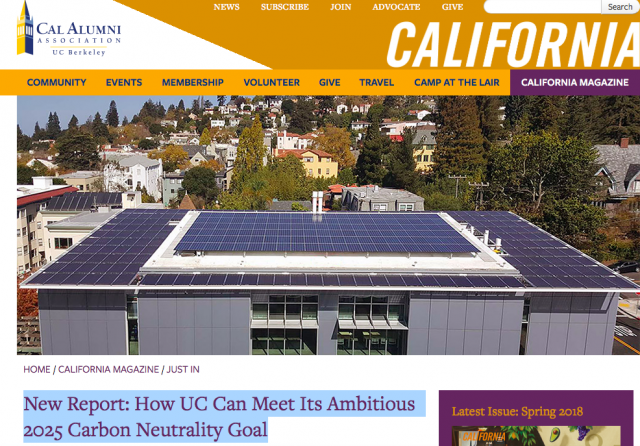NEWS New Report: How UC Can Meet Its Ambitious 2025 Carbon Neutrality Goal
The University of California believes it can go carbon neutral by 2025. That means zero carbon emissions from powering its buildings and vehicles on all ten campuses. But according to a recent report and related commentary by experts from across the system in the journal Nature, it could be a tough goal to reach. That’s a position shared by Berkeley professor and energy expert Dan Kammen, who was not affiliated with the report. “We’re not actually on pace for our 2025 goal,” he said—more like 2035 or 2040. “We need to accelerate. That’s one of the key things.”
To be fair, the goal—like the Kyoto Protocol, the Paris Agreement, and AB 32 before it— is an ambitious one. The university is specifically looking to light the way for large institutions the world over as well as the entire state of California, which is considering its own carbon neutrality target of 2045.
UC has a long way to go. From 2009 through 2015, the report shows, the university reduced electricity demand system wide through efficiency retrofits to offices, restaurants, residences, and more, netting UC more than $20 million a year. But it barely moved the needle on carbon emissions: 1.3 million metric tons of carbon dioxide annually in 2009 to 1.1 million in 2015.

Figure 1.4 from University of California Strategies for Decarbonization: Replacing Natural Gas
To bring that number down to zero over the next seven years, the university will need to “bend the curve,” the report concludes. Even with renewable energy coming online that wasn’t available a few years ago, the university must ramp up its efforts—rapidly.The authors of the report and commentary suggest a three-step approach. First is making buildings and other facilities even more efficient, which could net another $20 million in savings per year by 2025, the authors project.
Next is an interim measure, switching to biogas for campus power plants. Produced through the breakdown of plant matter in an oxygen-controlled environment, biogas is chemically identical to natural gas yet considered carbon-neutral. Although the fuel is already in use to a small extent on some campuses and more is planned, the authors note that due to supply limitations, it isn’t a solution that can scale up to national use. And while the move to biogas could put a huge dent in UC carbon emissions—almost all of which are currently associated with natural gas combustion—the fuel isn’t without risk. Leakage from gas infrastructure could significantly hinder UC’s efforts by releasing methane directly into the atmosphere, Kammen says.
The final step requires phasing out gas altogether. That means electrifying every campus from top to bottom—from the heating system in Dwinelle Hall to the maintenance truck parked out back—and purchasing power from only zero-emissions sources like solar, wind, and geothermal.
Campus electrification is straightforward enough for new buildings and domestic water heating, says Karl Brown, deputy director of the Berkeley-based California Institute for Energy and Environment and one of the report’s 27 authors. It’s much more difficult with existing buildings and high-temperature end uses, such as sterilization of lab equipment in, since that requires complete retrofits and likely removal of gas-burning facilities.
Camille Kirk, who directs UC Davis’ Office of Sustainability and was not involved in the report, says the 2025 goal is still feasible as long as the university makes the proper financial investments; receives full support from faculty, alumni, and the government, particularly around infrastructure renewal; and doesn’t insist on full electrification by 2025.
And while the authors of the report caution that UC’s leadership in this arena won’t mean much if others don’t follow suit, the specifics of its approach “[don’t] need to directly translate to spur other institutions’ thinking and creativity about solutions that might be better for them,” Kirk said.
Ultimately, the authors note, “bending the curve more sharply requires both academic and practical insights,” which is exactly what the university hopes to bring to the problem.
For the original article, click here.
Posted on April 23, 2018

You must be logged in to post a comment.